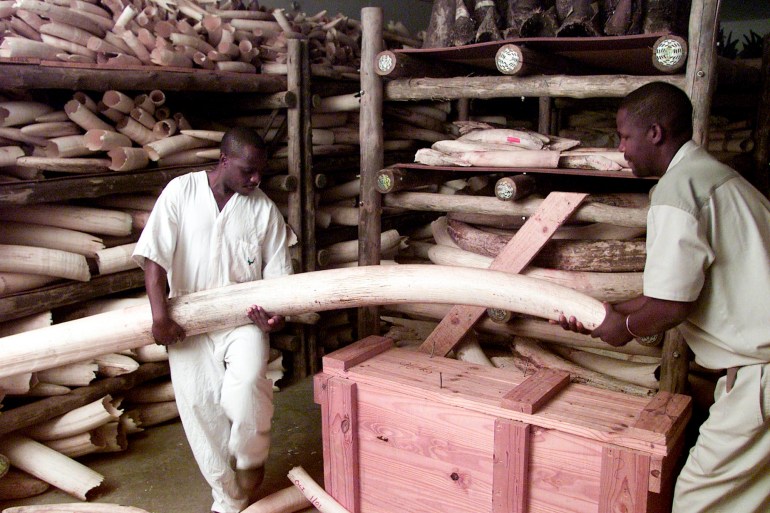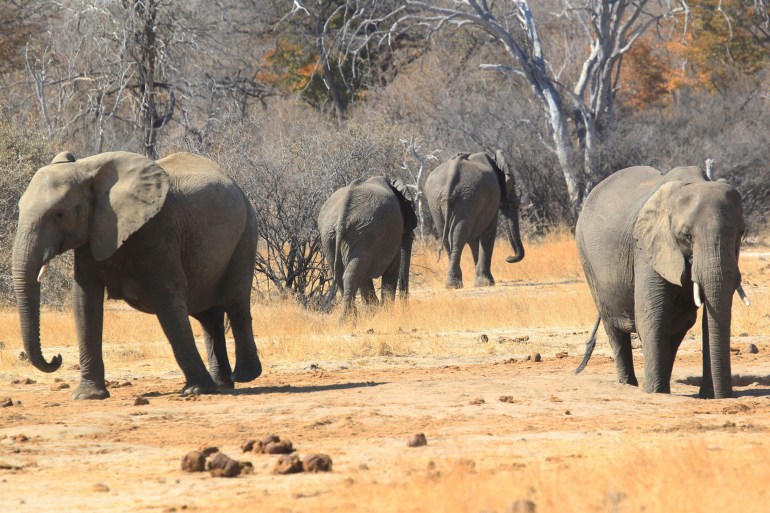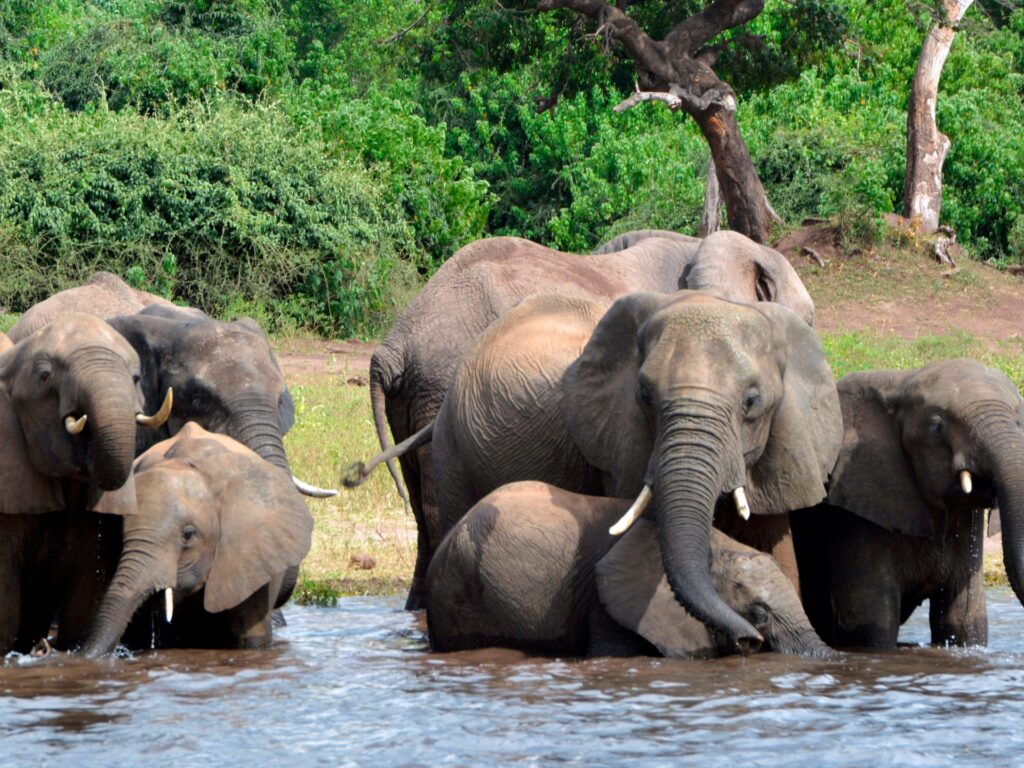Their large floppy ears and long snouts may make them spectacular to watch from a safe distance on safari, but these mammals can quickly become a threat to people living next to elephants. .
Elephant numbers in African countries have declined significantly in the past. However, due to conservation efforts since the 1980s, the population has slightly recovered. In southern African countries, where about half of the African elephant population lives, their growing numbers mean they are starting to come into conflict with humans.
As a result, some of these countries are trying to reduce their elephant populations. In Botswana, home to the world's largest population of elephants, President Mokgweetsi Masisi was trying to push through controversial policies, including encouraging hunting by wealthy tourists. Last month, he slammed the German government, which is considering banning imports of elephant parts, and threatened to send 20,000 jumbo cars to Berlin.
This diplomatic spat made for catchy headlines. But it underscored the serious challenges facing elephants, rural communities and conservationists working to find solutions.

How have elephant numbers changed in the past?
Elephant numbers declined dramatically across Africa from the 1970s to the 1980s as a result of a long period of overhunting and poaching for elephant meat and expensive ivory. According to the World Wildlife Fund (WWF), around 100,000 elephants were killed each year at the time. According to WWF, an estimated 3 to 5 million elephants roamed the continent around 1930, but by 1979 that number had fallen to 1.3 million. Dating back to the 1500s, researchers say African elephant populations have declined by about 98 percent.
Their numbers continued to decline until 1979, when conservation efforts, including significant bans on the sale of elephant parts and trophy hunting, halted the decline. According to WWF estimates, the total number of elephants in Africa is currently approximately 415,000.
This is still low compared to past numbers. In particular, the International Union for Conservation of Nature (IUCN) lists the African bush elephant as Endangered and the African Forest Elephant as Vulnerable, meaning that they still face the threat of extinction.
African bush elephants are larger animals that live in the savannah grasslands of southern and eastern Africa and make up 70 percent of the continent's total population. Its cousin, the African forest elephant, is native to western and central Africa and can be identified by its small, rounded ears and short, pointed tusks.
Botswana, Namibia, Angola, Zambia and Zimbabwe together account for more than half of Africa's elephant population. There are approximately 130,000 bush elephants in Botswana alone, about half the number in the region. With a population of around 2 million people, it is a large country comparable to France, which has a population of 67 million. There is approximately one elephant for every 15 people in Botswana.
Zimbabwe has the second largest population of bush elephants at around 100,000.

Why is the increasing number of elephants becoming an issue?
The feeding habits of the largest living land animals can dramatically alter ecosystems during their approximately 60-year lifetimes. Lucy King, a researcher at the non-profit organization Save the Elephants, said elephants have few natural enemies other than humans to control their numbers, and with humans out of the way, elephants can easily survive. That's what it means.
“If you leave it alone, it will breed well.” [and] Their survival rate is very good, so their numbers can increase very steadily over time,” says King.
Human population growth has doubled across Africa while elephant numbers have remained stable. According to the United Nations Population Fund, the population of Southern and Eastern Africa grew from 312 million in 1994 to 633 million in 2021. That growth has led humans to occupy more land and increasingly encroach on wildlife habitat. Settlements and farms also cut off roaming wild animals from water and food sources.
As a result, humans and elephants came into contact more frequently and began to conflict over the same resources. Herbivores often roam farms in search of food, tearing through the thatched roofs of huts, and damaging water pipes and other infrastructure. This angered local residents who launched retaliatory attacks. Their interactions can be deadly for both humans and beasts.
Climate change has also caused more elephants to wander farther and more unpredictable places than before in search of scarce food and water.
Zimbabwe is a peak conflict zone, but human-elephant conflict is increasing across the region, King said.
Countries such as Zimbabwe and Botswana blame elephant overpopulation and argue that reducing elephant numbers will reduce conflicts. However, some experts reject this idea, pointing out that there were once many more elephants in Africa.
How has the government approached this issue?
South Africa, Namibia, Zimbabwe, and Botswana have all tried to reduce elephant numbers in their territories at some point, but nearly all of their methods have been met with criticism and outright condemnation from animal rights groups. .
One of the practices is culling. This is when multiple animals (usually entire families) are intentionally targeted and killed together.
This practice was popular in the 1980s and 1990s. Approximately 14,000 elephants were culled in South Africa's Kruger Park between 1967 and 1995. But the practice was outlawed after African countries faced a global backlash, including widespread calls for tourists to boycott countries that slaughter elephants.
However, in 2008 South Africa lifted the ban on culling, ignoring global outcry. Zimbabwe, which killed around 50,000 elephants between 1967 and 1988, announced in 2021 that it was considering reviving the practice.
Conservationists like Dr. King argue that culling is especially cruel to elephants, who are emotionally intelligent and can experience trauma. What's more, this method is ineffective and “doesn't really scratch the surface,” she says.
The government is also seeking to simply sell some of the elephant herds, but animal rights groups say the elephants could be transported to zoos and used for human entertainment.
In 2021, Namibia auctioned 170 elephants, but only one-third were sold for 5.9 million Namibian dollars (about $400,000). Sources said there was so much bad press and criticism about the sale that the buyers were disappointed.
Another way to manage numbers is to allow trophy hunting. Trophy hunting is a sport in which each country invites adventure-seeking tourists (usually from the United States and other Western countries) to hunt a limited number of hunters at specific locations allotted to collect horns, hides, and tusks. It allows killing of animals. These tourists often target male elephants, or bulls, for their large tusks.
Government officials and hunters themselves in southern Africa argue that hunting helps naturally manage elephant populations and provides income for local communities. This incentivizes local communities to stop illegal poaching and ensure that elephant numbers remain stable and do not fall below sustainable levels. A hunting license can cost him as much as $10,000 depending on the animal being hunted.
African governments are often angered by Western countries' claims that the practice is unethical, so much so that Botswana has threatened to ship 20,000 elephants to Germany. Botswana's President Masisi has particularly advocated for the return of hunting licenses. In 2019, after he took office, Botswana lifted a five-year ban on elephant hunting.
What are the arguments against hunting?
Some conservationists ignore this outrage from African governments.
“I think it's very short-sighted. I think it's a convenient smokescreen to hide and justify trophy hunting, which is big business,” said the nonprofit Good Governance Africa's Wildlife Economy. says scholar Ross Harvey. Harvey points out that much of the money from trophy hunting (first introduced in colonial Kenya) goes to wealthy businessmen who own trophy hunting companies, rather than to conservation efforts.
“It is very questionable how much of that actually goes into conservation, certainly not enough to protect the landscape, and it is also very questionable how much of it ends up in the hands of poor local people. It’s clear,” he added. “But now that the elephants are gone, you're living with the negative effects of removing all the bulls, which are normally at the peak of their reproductive potential.”
Older males often help guide younger bulls, teaching them where to eat and water and how to behave. Researchers have found that young males can become aggressive when killed.
“My prediction is that there will be more conflict between humans and elephants, because if you remove all the bulls that discipline the herd, you're going to see more crop raiding, not less,” Harvey said.
So what could be the solution?
Mr Harvey said that while elephant numbers may have increased since the 1990s, the real problem was not “overpopulation”, but rather that elephants, and all wild animals, use the land they use to migrate in search of food and habitat. He says this is due to humans cutting out the connecting lands and corridors. Freeing up these spaces would reduce human-elephant interactions, he argues.
“Shooting them only makes the problem worse,” he says.
“There are really only two solutions,” King said. “The first thing is to have some breathing space. We put up fences here and there and keep stopping. [elephants]As such, they are forced into areas where they can deplete vegetation at an incredible rate. The only solution is to release the valve and ensure that the fence is lowered. That doesn't mean elephants should be everywhere…but you can't fence them off. ”
In northern Botswana, an initiative called the Eco-Exist Project has worked with local residents to identify and demarcate more than 60 elephant corridors across the vast Okavango Delta. The team then worked with the community to replan the layout of the village so that farms, homes, and other infrastructure were located away from these “elephant roads.”
It is not yet clear how much the project has reduced human-elephant conflict, but so far about 65,000 hectares (160,600 acres) of farmland owned by 500 farmers have been protected. Farmers also come together to share fenced farm spaces and crops such as chili peppers, which elephants dislike and avoid.
Another solution, King says, is to teach people how to live more harmoniously with animals. Her research into natural methods of repelling elephants from villages and farms in southern Kenya has yielded several results.
King noticed that when he played recordings of the sounds of bees swarming, the elephants quickly dispersed. She then began experimenting with building beehive fences around some of her farms. This is a rudimentary method suitable for rural areas, where the farmer only needs a pole to attach the box that will house the hive. The women then harvest the honey and sell it to earn extra income. This method is currently used in 17 African countries and some regions of Asia.
“We're really proud of this…and it's completely open source,” King says. “We let people have a manual, develop their own biofence projects, and run them. And what's interesting is that it's actually working everywhere.”
However, this method only works on small land areas. It is also threatened by drought, which is not good for bees.

